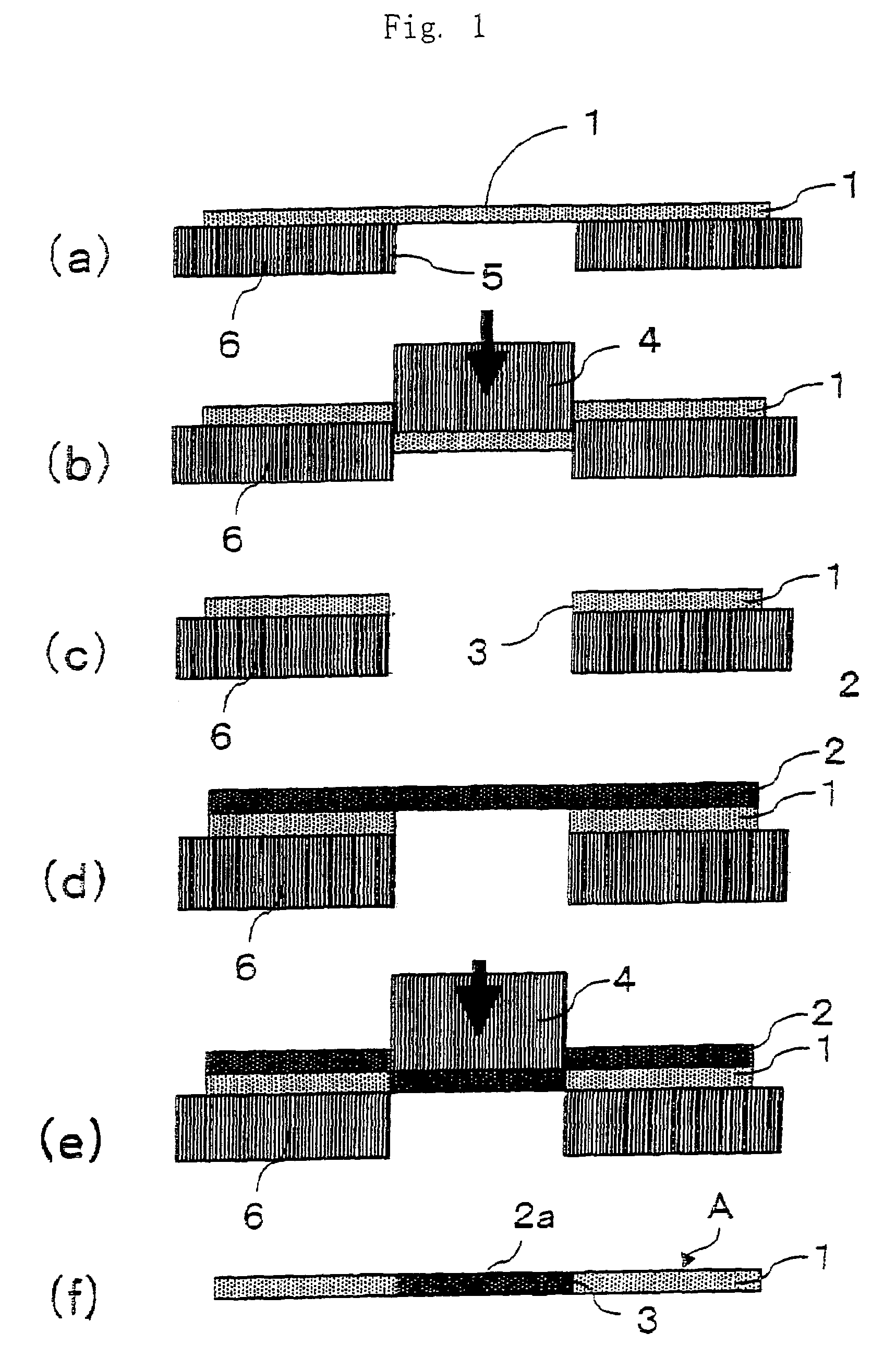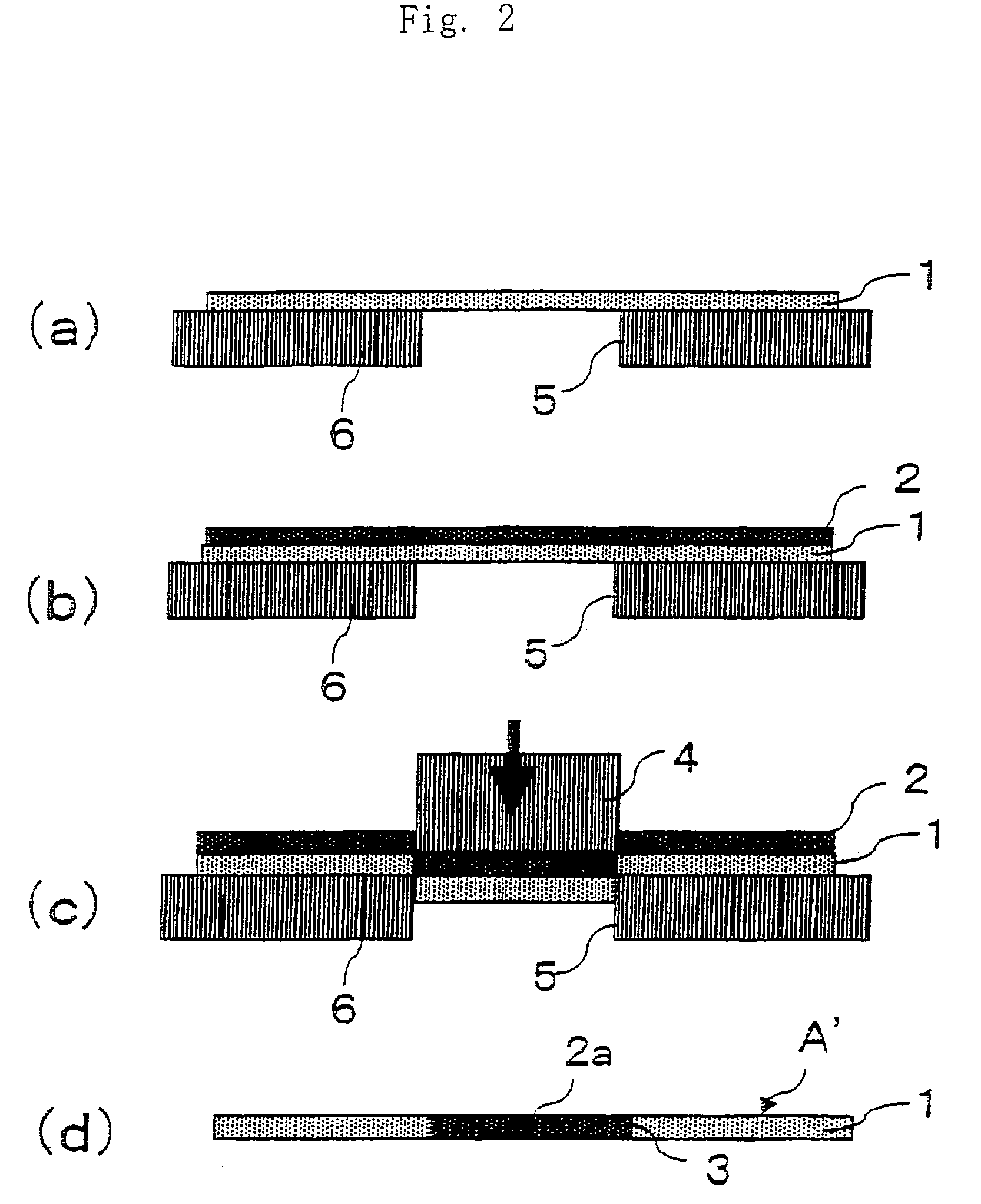Method of producing a composite sheet and method of producing a laminate by using the composite sheet
- Summary
- Abstract
- Description
- Claims
- Application Information
AI Technical Summary
Benefits of technology
Problems solved by technology
Method used
Image
Examples
example 1
(Preparation of a First Ceramic Sheet)
[0286]To 100 parts by mass of a ceramic composition comprising 60% by volume of a glass powder having an average particle size of 1.8 μm and 40% by volume of an alumina powder having an average particle size of 2.4 μm, there were added 12 parts by mass of a polyisobutyl methacrylate as an organic binder and 54 parts by mass of toluene as a solvent. The mixture was mixed together with a ball mill for 24 hours to prepare a slurry thereof.
[0287]By using this slurry, a first ceramic sheet A measuring 20 mm long, 20 mm wide and 120 μm thick was prepared by the doctor blade method.
[0288]A metal paste was prepared by mixing 100 parts by mass of a copper powder having an average particle size of 1.5 μm, 12 parts by mass of an acrylic resin as an organic binder and 10 parts by mass of terpineol as a solvent, and was applied onto the surface of the first ceramic green sheet A in a predetermined pattern by the screen-printing method.
[0289]Further, through ...
example 2
[0301]The first ceramic sheet A and the resin sheet B prepared in Example 1 were laminated as shown in FIG. 2. Then, the upper punch of the punching device was lowered until the lower surface of the upper punch was in flush with the surface of the sheet A.
[0302]The upper punch was raised, and it was confirmed that there had been formed a composite sheet C3 of a structure with the resin sheet B being buried in the through hole of the first ceramic sheet A.
[0303]Next, a total of five layers of green sheets were laminated in quite the same manner as in Example 1 by using an adhering solution, i.e., the composite sheet C3, a composite sheet C4 prepared in the same manner as C3, and ceramic green sheets D1, D2 and D3 on which an ordinary wiring pattern has formed but which have not been compounded, and the laminate was heated at a temperature of 60° C. under a pressure of 5 MPa.
[0304]The thus press-laminated sample was observed for its deformation of the ceramic green sheet at the portio...
example 3
[0316]To 100 parts by mass of a ceramic composition comprising 60% by mass of a carbon powder having an average particle diameter of 40 μm and 40% by mass of a butyral resin having a glass transition point of 60° C., there was added 150 parts by mass of toluene and then the components were mixed.
[0317]Then, the mixture was stirred with a ball mill to prepare a slurry.
[0318]The slurry was deformed by stirring under reduced pressure, and then using the deformed slurry, there was formed a burn-and-extinguish sheer having 200 μm thickness by doctor-blade method.
[0319]A ceramic wiring substrate having a cavity was prepared quite the same manner as Example 1 except that the above mentioned carbon sheet was used instead of a resin sheet as a burn-and-extinguish sheet.
[0320]In the preparation steps, the press-laminated sample was observed for its deformation of the ceramic green sheet at the portion where the burn-and-extinguish sheet (carbon sheet) was buried.
[0321]However, no deformation ...
PUM
| Property | Measurement | Unit |
|---|---|---|
| Percent by volume | aaaaa | aaaaa |
| Percent by volume | aaaaa | aaaaa |
| Particle size | aaaaa | aaaaa |
Abstract
Description
Claims
Application Information
 Login to View More
Login to View More - R&D
- Intellectual Property
- Life Sciences
- Materials
- Tech Scout
- Unparalleled Data Quality
- Higher Quality Content
- 60% Fewer Hallucinations
Browse by: Latest US Patents, China's latest patents, Technical Efficacy Thesaurus, Application Domain, Technology Topic, Popular Technical Reports.
© 2025 PatSnap. All rights reserved.Legal|Privacy policy|Modern Slavery Act Transparency Statement|Sitemap|About US| Contact US: help@patsnap.com



